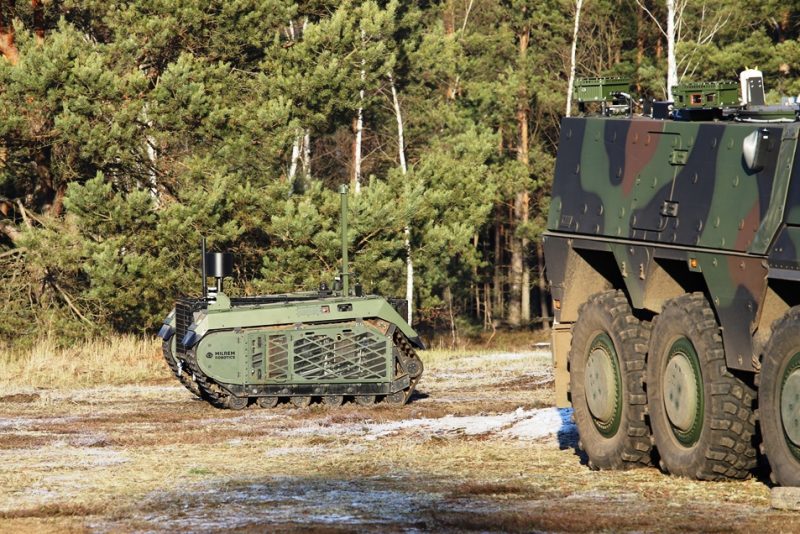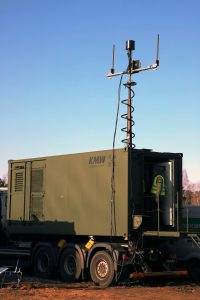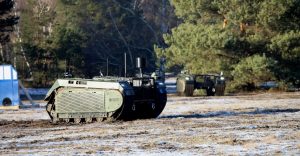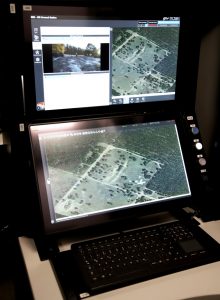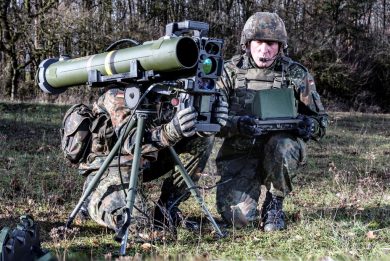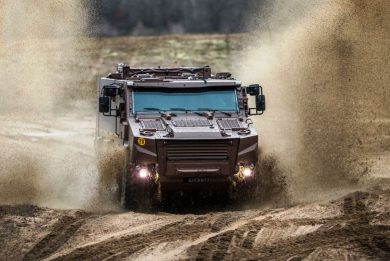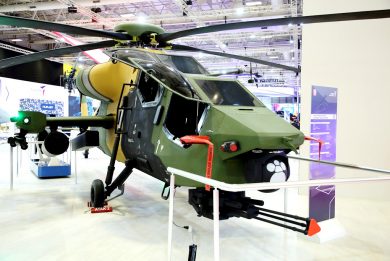The IMUGS I project
From his command post hosted in an armoured shelter the commander sends out his orders, the aim of the deployed force being to seize a small village occupied by the enemy. This time however the first orders are not issued as a usual FRAGO, but come as synthetic data that include the mission – reconnaissance, the area to be treated, the number and type of ground and air assets available, and the types of sensors. All is done on the command and control screen hosted in an armoured shelter purposely fitted by KMW. “A key element is the manned part, allowing operating and coordinating the unmanned assets, which in this demonstration is fitted in our container. This is where the common operational picture is formed and then distributed to all the other players on the battlefield,” Mathias Nöhl, Senior Vice-President Division Manager System Technologies at KMW explains to EDR On-Line, adding that KMW is also involved in simulation, which allows operating UGVs in virtual scenarios, allowing soldiers to test their effectiveness ahead of development. What is different in the iMUGS I current demonstration compared to previous ones, is that on the receiving side of the orders there is no lieutenant who will then draft his plan and issue detailed orders to the assets on the field. At Lehnin orders are issued to the computer that hosts autonomy algorithms, which in turn issues orders to the selected autonomous vehicles.
The iMUGS is the largest European land defence robotics project and is running under the auspices of the European Defence Industrial Development Programme (EDIDP) funded by the European Commission. It involves seven countries, Estonia, Belgium, Finland, France, Germany, Latvia and Spain, Estonia being mentioned first as it is an Estonian company, Milrem Robotics, which was assigned the role of project coordinator as it provides the selected UGV, the THeMIS. Twelve more companies representing all participating countries are part of the team that in the last two years worked for delivering a set of capabilities that will become the base for further developments, seven sub-projects having been identified that are listed here, with the companies involved in each of them, the first mentioned being the leading company:
- Subproject-1, System Integration (Milrem Robotics)
- Subproject-2, Autonomy (Safran, Milrem Robotics, Nexter, Diehl Defence)
- Subproject-3, Cyber security (Talgen)
- Subproject-4, Communications (Bittium, LMT)
- Subproject-5, Swarming (Belgian Royal Military Academy, detOcean, Insta)
- Subproject-6, Command, Control and Interoperability (GMV, Sol.One)
- Subproject-7, Manned-Unmanned Teaming (KMW, Nexter, Milrem Robotics)
“The first few minutes of this demo were the most important, when the three UGVs carried out the reconnaissance mission by themselves operating in swarm mode. The three THeMIS avoided obstacles, shared information, all within a cyber secure framework, with all necessary layers,” Martin Jöesaar, Chief of participating member states project office told EDR On-Line following the first part of the demonstration. “It is the first time we saw autonomy and swarming together with these platforms. This was the real novelty, as for the rest scenarios and systems were the same of previous demos,” he added.
Kuldar Väärsi, CEO Milrem Robotics, confirmed: “The very big change from Demo 5 to Demo 6 is the addition of the swarming layer which gives global autonomy. Now we can give orders via the command and control system and the swarming layer takes over these orders, creates the scenario and sends it to unmanned vehicles, which in their turn operate autonomously within that scenario. Previously each vehicle was tasked alone by an operator; now one operator establishes the task, the area to be covered, and UGVs operate on their own, therefore a single operator can deal with 10-20 systems at the same time or even more.” The command software remains in touch with the UGVs, therefore adjustments can be done autonomously while the mission is ongoing. “Should one asset be lost due to enemy fire or a technical failure, the algorithm will re-task remaining systems in order to carry out the mission, the same happening if one of the assets runs low on fuel or batteries,” Mr. Väärsi explained to EDR On-Line. That said the C2 operator can take a UGV out of the swarm, should it have problems, and eventually reinsert it in the swarm at a later moment, once problems are solved, and it can even decide in which areas UGVs can operate autonomously and in which they fall under direct control from the console.
The three UGVs involved in the initial part of the demonstration were THeMIS from Milrem Robotics, the Estonian company which tracked systems have been acquired, for operational or testing purposes, by 10 different international customers, and were deployed in operation by the Estonian Army in Mali and now by Ukrainian forces.
Back in the command and control shelter, three working stations can be seen, although one is that hosting the IRIS software, adopted by the Spanish Army, provided by GMV of Spain which generates the Common Operational Picture that is distributed to all units, the other main task being to verify interoperability with other C2 systems, which is ensured by the respect of two STANAGs, 4559 (ISR Networks) and 5527 (C2). Add-on Artificial Intelligence algorithms are obviously at the heart of the system; however when asked about the role of machine learning, considering the capability of refining skills following successive exercises, EDR On-Line was told that this is not done automatically, but it is mediated by analysts. “Taking in count field experience acquired during training might bring in elements dictated by training constraints, that might lead to undesired results,” we were told, therefore inputs from the terrain are taken in as lessons learned, analysed, and only then relevant elements are fed into the iterative learning process.
The certifiable ground control station was developed by Sol.One of Belgium and allows monitoring a fleet of ground and air assets operating autonomously, eventually taking control of some of them should the need arise. From his post the operator can select ay type of sensor installed on moving assets on the field to acquire needed information in an optimal way.
A Blue Force Tracking system operated on mobile networks, 4G/5G, was also employed, provided by LMT (Latvijas Mobilais Telefons) of Latvia, while the overall tactical communication mesh network was provided by Bittium of Finland. Multiple gateways were used for sending different streaming from different sensors, while vehicles were fitted with directional antennas in order to have the strongest possible signal hence the higher throughput to ensure the best possible two-way link between them and the C2 post.
The autonomy layer at vehicle level is ensured by a system which backbone was developed by Safran of France, the same company providing some of the sensing functionalities, such as pedestrian and vehicles detection as well as road detection, based on image processing and deep learning algorithms. According to Safran, the backbone has been developed to allow easy integration of third parties functionalities, and is platform agnostic, therefore it can be migrated on any UGV with minimal adaptation. Obstacle avoidance was developed by Nexter of France, the LiDAR-based system having been developed for the company Z Trooper and migrated to iMUGS. As part of Subproject-2, Diehl Defence is responsible for hardware and software architectures of autonomous functions, as well as for safety and security analysis. While UGVs are on the move the autonomy module updates the SLAM-map (Simultaneous Localization And Mapping), which allows it ensuring accurate navigation even in GNSS-denied environment, algorithms exploiting computational geometry and computer vision inputs, comparing those with the available map.
The autonomy subsystem was installed on THeMIS UGVs, where two other elements were added both from Talgen, the Estonian company in charge of cybersecurity issues. One of them, the iMUGS Cyber Defence System (CDS) was designed to defend the UGV from cyber supply chain security breaches, and is capable to detect and respond to those threats. A second one is an algorithm dedicated to GNSS cybersecurity, capable to detect attacks, notifying the threat and activating alternative navigation systems through the CDS.
Photos by P. Valpolini

